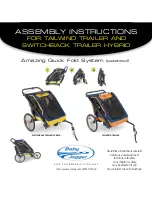
5
4
a vehicle, which may become overheated by the
sun.
• Do not store LP tanks in an area where children
play.
• Storage of an appliance indoors is permissible
only if the cylinder is disconnected and removed
from the appliance.
LP Tank
The LP tank used with your appliance must meet
the following requirements:
• Purchase LP tanks only with these required
measurements: 12” (30.5cm) (diameter) x 18”
(45.7cm) (tall) with 20 lb. (9 kg.) capacity
maximum.
• Be constructed and marked in accordance
with specifications for LP tank of the U.S.
Department of Transportation (DOT) or the
National Standard of Canada, CAN/CSA-
B339, Cylinders, Spheres and Tubes for the
Transportation of Dangerous Goods.
• The propane cylinder used with this appliance
must include a collar to protect the cylinder
valve.
LP tank valve must have
• Type 1 outlet compatible with regulator or
appliance.
• Safety relief valve.
• UL listed Overfill
Protection Device (OPD).
This OPD safety feature
is identified by a unique
triangular hand wheel.
Use only tanks equipped
with this type of valve.
LP tank must be arranged for vapor withdrawal.
LP (Liquefied Petroleum Gas)
• LP gas is non-toxic, odorless and colorless when
produced. For Your Safety, LP gas has been
given an odor (similar to rotten cabbage) so
that it can be smelled.
• LP gas is highly flammable and may ignite
unexpectedly when mixed with air.
LP Tank Filling
• Use only licensed and experienced dealers.
to check for gas leaks.
Use a clean paintbrush and 50/50 soap and water
solution. Use mild soap and water. Do not use
household cleaning agents. Damage to gas train
components can result. Brush soapy solution onto
all weld seams and entire valve area.
WARNING
If “growing” bubbles appear, do not use
or move the LP tank. Contact an LP gas
supplier or your fire department.
Installing The Lp Gas Cylinder Onto The Grill
1. Check that the cylinder valve is closed by
turning the knob clockwise.
2. Hang the cylinder from the tank hook.
TANK HOOK
3. Orient the cylinder such that the valve opening
faces the left side of the grill, and so that the
hose is not kinked or damaged.
4. Attach or detach regulator to the LP gas
cylinder only when cylinder is at rest in the
tank holder.
5. Remove the protective cap from LP tank valve.
Perform a leak test.
• The regulator may make a humming or whistling
noise during operation. This will not affect the
safety or use of the appliance.
• Clean and inspect the hose before each use of
the appliance. If there is evidence of abrasion,
wear, cuts or leaks, the hose must be replaced
prior to the appliance being put into operation.
See product sheet for hose & regulator
information.
• Do not block holes in bottom or sides of
appliance.
• Never operate appliance with LP tanks out
of correct position specified in Assembly
Instructions.
• Always close LP tank valve and remove coupling
nut before moving LP tank form specified
operating position.
• NEVER store a spare LP tank under or near
appliance or in enclosed areas. NEVER fill the
cylinder beyond 80% full. An overfilled spare LP
tank is hazardous due to possible gas released
from the safety relief valve. Failure to follow
these instructions exactly could cause a fire
resulting in death or serious injury.
• If you see, smell, or hear escaping gas,
immediately get away from the LP tank/
appliance and call your fire department.
• All spare LP tanks must have safety caps
installed on the LP tank outlet.
LP Tank Removal, Transport and Storage
• Turn OFF all control knobs and LP tank valve.
Turn coupling nut counterclockwise by hand only
– do not use tools to disconnect. Install safety
cap onto LP tank valve. Always use cap and
strap supplied with valve. Failure to use safety
cap as directed may result in serious personal
injury and/or property damage.
• A disconnected LP tank in storage or being
transported must have a safety cap installed
(as shown).
Do not store an LP tank
in enclosed spaces such
as a carport garage,
porch, covered patio or
other building. Never
leave an LP tank inside
• LP dealer must purge tanks before filling.
• Dealer should NEVER fill LP tank more than
80% of LP tank volume. Volume of propane in
tanks will vary by temperature.
• A frosty regulator indicates gas overfill.
Immediately close LP tank valve and call local
LP gas dealer for assistance.
• Do not release liquid propane (LP) gas into the
atmosphere. This is a hazardous practice.
• To remove gas from LP tank, contact an LP
dealer or call a local fire department for
assistance. Check the telephone directory
under “Gas companies” for nearest certified LP
dealers.
LP Tank Exchange
• Many retailers that sell appliances offer you the
option of replacing your empty LP tanks through
an exchange service. Use only those reputable
exchange companies that inspect, precision fill,
test and certify their cylinders. Exchange your
tank only for an OPD safety feature-equipped
tank as described in the “LP Tank” section of
this manual.
• Always keep new and exchanged LP tanks in
upright position during use, transit or storage.
• Leak test new and exchanged LP tanks BEFORE
connecting to appliance.
LP Tank Leak Test
WARNING
Appliance must be leak checked
outdoors in well-ventilated area, away
from ignition sources such as gas fired
or electrical appliances. During leak
test, keep appliance away from open
flames or sparks.
For your Safety
• Leak test must be
repeated each time LP
tank is exchanged or
refilled.
• Do not smoke during leak
test.
• Do not use an open flame
Safety Cap
OPD
Hand
Wheel

























